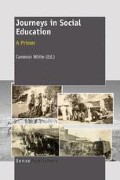Abstract
This chapter examines the internal conflict between teaching US democracy and ageism within the sliding continuum of living, learning, and experiencing democracy. It also explores the limits of schooling in creating a responsive citizenry and possible examples of how social educators can overcome ageism within schooling models, to move more closely toward democratic classrooms. Sliding continuums, located at the start of each section, augment the traditional section headers to represent the journey toward having less ageism in schools. As social educators, many things may be outside of our control in relation to teaching in a democratic system, but we can choose on each continuum where students will experience democracy within our classrooms.
Access this chapter
Tax calculation will be finalised at checkout
Purchases are for personal use only
Preview
Unable to display preview. Download preview PDF.
References
Anderson, D. (1999). Understanding the impact of post-visit activities on students’ knowledge construction of electricity and magnetism as a result of a visit to an interactive science center. Brisbane, Australia: Queensland University of Technology.
Apple, M. (1992). Education, culture, and class power: Basil Bernstein and the Neo-Marxist sociology of education. Educational Theory, 42(2).
Bamberger, Y., & Tal, T. (2005). Learning in a personal-context: Levels of choice in a free-choice learning environment at science and natural history museums. Paper presented at the European Association for research on Learning and Instruction Conference, Nicosia, Cyprus.
Bianco, M. W. (1975). The velveteen rabbit or, how toys become real. New York: Avon.
Collodi, C. (1960). Pinocchio. New York: Crown.
Counts, G. S. (1934). The social foundations of education. New York, Chicago etc.: C. Scribner’s sons.
Dewey, J. (1902). The child and the curriculum. Chicago: University of Chicago Press
Ellenbogen, K. M. (2002). Museums in family life: An ethnographic case study. In G. Leinhardt, K. Crowley, & K. Knutson (Eds.), Learning conversations: Explanation and identity in museums (pp. 81-101). Mahwah, NJ: Lawrence Erlbaum Associates.
Falk, J. H. & Dierking, L. D. (2000). Learning from museums: Visitor experiences and the making of meaning. Walnut Creek, CA: Alta Mira Press.
Freire, Paulo. (1998). Pedagogy of the oppressed. New York: Continuum Press.
Freire, P., & Giroux, H. A. (1989). Pedagogy, popular culture, and public life. In H. A. Giroux & I. Roger (Ed.), Popular culture: Schooling and everyday life (Critical Studies in Education Series ed.). Toronto: OSI Press.
Giroux, H. A. (2001). Stealing innocence: Corporate culture’s war on children. London: Palgrave Macmillan.
Giroux, H., Shumway, D., Smith, P., & Sosnoski, J. (1984). The need for cultural studies: Resisting intellectuals and oppositional public spheres. Dalhousie Review, 64, 472-486.
Griffin, J. (1998). School-museum integrated learning experiences in science: A learning journey.Unpublished PhD dissertation, University of Technology, Sydney, Australia.
Griffin, J. (2007). Students, teachers, and museums: Perspectives on a decade of research. In J. H. Falk, L. D. Dierking, & S. Foutz (Eds.), In principle, in practice: Museums as learning institutions (pp. 31-42). Walnut Creek, CA: Alta Mira Press.
Habermas, J. (1981). The theory of communicative action. London: Beacon Press.
hooks, B. (2000). Where we stand: Class matters. New York: Routledge.
Johnson, C. (1981). Love grows one by one. On Might as well make it love [album]. Grand Rapids, MI: Carol Johnson, Noeldner Music.
Lebeau, R., Gyamfi, P., Wisevich, K., & Koster, E. (2001). Supporting and documenting choice in free-choice science learning environments. In J. H. Falk (Ed.), Free-choice science education: How we learn science outside of school (pp. 133-148). New York: Teachers College Press.
Lowry, L. (1993). The giver. Boston: Houghton Mifflin.
Lyotard, J.-F. (1987). Re-Writing modernity. SubStance, 16(3), 54, 3-9. Retrieved from http://www.jstor.org/stable/3685193
McLaren, P., & Lankshear, C. (1994). Politics of liberation: Paths from Freire. London; New York: Routledge.
Orwell, G. (1949). Nineteen eighty-four. London: Secker & Warburg.
Pandell, K., & dePaola, T. (1994). I love you sun, I love you moon. Newnan, GA: Hippo.
Pinar, W. (1975). Curriculum theorizin: The reconceptualists. Berkeley, CA: McCutchan Pub. Corp.
Rennie, L. J., & Johnston, D. J. (2007). Research on learning from museums. In J. H. Falk, L. D. Dierking, & S. Foutz (Eds.), In principle, in practice: Museums as learning institutions (pp. 57-76). Walnut Creek CA: Alta Mira Press.
Vonnegut, K. (1969). Slaughterhouse-five; or, the children’s crusade, a duty-dance with death. New York: Dell Pub. Co.
White, C. (1999). It’s not just another new thing: Technology as a transformative innovation for social studies teacher education. Journal of Technology and Teacher Education, 7(1), 3-12.
Willis, P. (1977). Learning to labor: How working class kids get working class jobs. New York: Columbia University Press.
Author information
Authors and Affiliations
Editor information
Editors and Affiliations
Rights and permissions
Copyright information
© 2011 Sense Publishers
About this chapter
Cite this chapter
Summers, E.J., Esdorn, A. (2011). Recognizing and (Re)cognizing Ageism in EC–12 US Social Education. In: White, C. (eds) Journeys in Social Education. SensePublishers. https://doi.org/10.1007/978-94-6091-358-7_11
Download citation
DOI: https://doi.org/10.1007/978-94-6091-358-7_11
Publisher Name: SensePublishers
Online ISBN: 978-94-6091-358-7
eBook Packages: Humanities, Social Sciences and LawEducation (R0)


